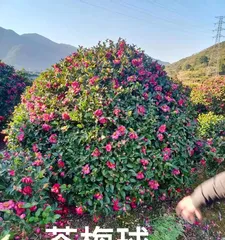Camellia Japonica is one of the traditional bonsai arts in China. Pruning the Camellia Japonica bonsai is an important part of its cultivation. Mastering the best pruning time can help us better beautify the Camellia Japonica bonsai and enhance its ornamental value. This article will detail the best time to prune Camellia Japonica and related considerations.

I. Basic Understanding of Camellia Japonica Growth Patterns
The growth patterns of Camellia Japonica are the foundation for pruning. The Camellia Japonica bonsai should be pruned according to its growth habits and shaping characteristics. Understanding the growth patterns of Camellia Japonica allows for better pruning.
II. Spring Pruning
Spring is a period of vigorous growth for Camellia Japonica and is the best time for large-scale pruning. Pruning in spring can create new shapes and adjust leaf density and branch positions, making the Camellia Japonica bonsai more aesthetically pleasing.

III. Summer Pruning
Summer is the peak growth period for Camellia Japonica. At this time, pruning should be minimal, mainly removing dead leaves, diseased leaves, and messy branches. The focus of summer pruning is to maintain the fresh state of the Camellia Japonica bonsai and appropriate branch length.
IV. Autumn Pruning
Autumn is the concluding period of growth for Camellia Japonica, during which it enters a dormant period. Autumn pruning should reduce the amount of cutting, mainly focusing on shaping and removing yellow leaves, dead branches, and adjusting the crown balance.
V. Winter Pruning
Winter is the dormant period for Camellia Japonica. At this time, only light pruning should be performed, mainly cutting the tips of branches to promote new growth. It is also important to maintain soil moisture and ventilation.

VI. The Relationship Between Pest and Disease Control and Pruning
Camellia Japonica bonsai are susceptible to pests and diseases, so pest and disease control measures should be strengthened during the pruning process. Timely detection and treatment of pests and diseases can effectively improve the growth and ornamental effect of the Camellia Japonica bonsai.
VII. Selection and Use of Pruning Tools
Pruning Camellia Japonica requires the selection of appropriate tools. Common tools include scissors, shears, and pruning saws. When using tools, pay attention to safety, use them correctly, and keep them clean and well-maintained.
VIII. Selection and Management of Potting Soil
Camellia Japonica bonsai requires suitable potting soil to ensure its growth condition. At the same time, in the management of potting soil, attention should be paid to appropriate watering and fertilization to avoid problems caused by improper water and fertilizer.
IX. Preparations Before Pruning
Before pruning Camellia Japonica, sufficient preparation is required, including checking for pests and diseases, choosing pruning methods and tools, and cleaning and disinfecting pruning tools. Only with full preparation can effective pruning be carried out.
X. Camellia Japonica Pruning Techniques
Pruning techniques for Camellia Japonica are an important part of beautifying the bonsai. Correct pruning techniques can create more natural and beautiful shapes. Common techniques include thinning branches, controlling length and density, and double branch reduction.
XI. Post-Pruning Care
After pruning Camellia Japonica, corresponding care work is required, including watering, fertilizing, and ventilation. At the same time, the pruning wounds should be properly treated to promote healing and healthy growth.
XII. Care of Camellia Japonia Bonsai
The care of Camellia Japonica bonsai is an important task in addition to pruning. The growth of Camellia Japonica bonsai requires suitable environmental conditions, such as light, temperature, and humidity. In daily care, attention should be paid to these aspects.
XIII. Common Problems and Solutions for Camellia Japonica Bonsai
During the growth process, Camellia Japonica bonsai can easily encounter various problems, such as yellow leaves, wilting, and pests. Before and after pruning, inspection and treatment are necessary to solve problems in a timely manner.
XIV. How to Choose a Camellia Japonica Bonsai
When selecting a Camellia Japonica bonsai, multiple factors need to be considered, such as crown shape, leaf density, and branch position. At the same time, it is also necessary to pay attention to purchasing authentic and high-quality varieties to ensure their growth and beautification effects.
XV.
The best time to prune Camellia Japonica is determined by the season and growth patterns. Spring and autumn are the best times for large-scale pruning, while summer and winter should involve light pruning. Correct pruning methods and techniques can create more natural and beautiful shapes, and strengthening pest and disease control can improve the growth and ornamental value of the Camellia Japonica bonsai. In daily care, it is also necessary to pay attention to multiple aspects to keep the Camellia Japonica bonsai in a healthy and beautiful state.